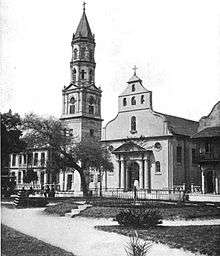Juan Nepomuceno de Quesada
| Juan Nepomuceno de Quesada y Barnuevo | |
|---|---|
| 61st Governor of Spanish Honduras | |
|
In office 11 August 1783 – 1789 | |
| Preceded by | Francisco Aybar |
| Succeeded by | Alejo García Conde |
| 2nd Governor of Spanish East Florida | |
|
In office July 1790 – March 1796 | |
| Preceded by | Vicente Manuel de Céspedes y Velasco |
| Succeeded by | Bartolomé Morales |
| Personal details | |
| Born | 1738 |
| Died | 1798 |
| Profession | Military officer and administrator (governor of Honduras and East Florida) |
| Religion | Roman Catholic |
Juan Nepomuceno de Quesada y Barnuevo Arrocha[1] (1738–1798)[2] was a military officer who served as Governor and intendant of Honduras between 1783 and 1789, and Governor of East Florida from July 1790 to March 1796.
Biography
De Quesada was born in 1738 at Jaén, Spain.[3] He joined the Spanish Royal Army in his youth, attaining the ranks of Brigadier of the Infantry of the Royal Armies and Commander General of the presidio of St. Augustine.[4][2]
De Quesada was appointed Governor and intendant of Honduras in 1783, and remained in this office until 1789, when he was replaced in the Honduran government by Alejo García Conde.[5]

In 1790 De Quesada was appointed Governor of East Florida by Charles IV of Spain.[6][7] to replace Vicente Manuel de Céspedes He assumed the governorship in July 1790, during the Nootka Sound Crisis.[1]
After his arrival at Saint Augustine, as a consequence of the Nootka Crisis, De Quesada revamped the defenses of the city, which were not extensive enough, according to him and his engineer, Mariano de la Roque. The garrison was small and dispirited, as the Spanish royal subsidy (Situado)[8] had not arrived in Florida since 1787.[1]
In the course of his service as governor of the province, De Quesada also obtained the titles of Vice Royal Patron, and Subdelegate of St. Augustine and the province.[4] Construction of the Cathedral was begun in 1793 under his administration and finished in 1797, a year after he left his post.[9]
De Quesada banned the recognition of runaway slaves who had fled from the British colonies to Florida seeking freedom. He became ill in February 1796, and continued to serve as governor of East Florida only until March of that year, when he was succeeded by Bartolomé Morales. He died in 1798.
References
- 1 2 3 Paul E. Hoffman (2002). Florida's Frontiers. Indiana University Press. p. 243. ISBN 978-0-253-34019-1.
- 1 2 Guillermo Lohmann Villena (1993). Los americanos en las órdenes nobiliarias. 1 (2nd ed.). Editorial CSIC – CSIC Press. p. 408. ISBN 978-84-00-07351-0.
- ↑ Francisco Xavier de Santa Cruz y Mallén (1950). Historia de familias cubanas. Editorial Hércules. p. 261.
- 1 2 "Mitchell v. Furman, 180 U.S. 402 (1901)". Supreme.justia.com. Justia. 2016. Archived from the original on March 4, 2016. Retrieved 12 June 2016.
- ↑ Rómulo E. Durón (April 14, 1906). "Dos libros de Historia: notas bibliográficas". Revista del Archivo y de la Biblioteca Nacional de Honduras (in Spanish). Tipografía Nacional. 2: 365.
- ↑ Rafael B. Abislaimán (2008). Peregrinando a San Agustín: al encuentro del siervo de Dios, Padre Félix Varela. Ediciones Universal. p. 155. ISBN 978-1-59388-120-7.
- ↑ Carnegie Institution of Washington Publication. Carnegie Institution of Washington. 1910. p. 54.
- ↑ Sherry Johnson (2011). Climate and Catastrophe in Cuba and the Atlantic World in the Age of Revolution. Univ of North Carolina Press. pp. 157–158. ISBN 978-0-8078-3493-0.
- ↑ "Cathedral of St. Augustine: St. Augustine, Florida". NPS.gov. National Park Service, U.S.Department of the Interior. 2016. Archived from the original on April 6, 2015. Retrieved 12 June 2016.